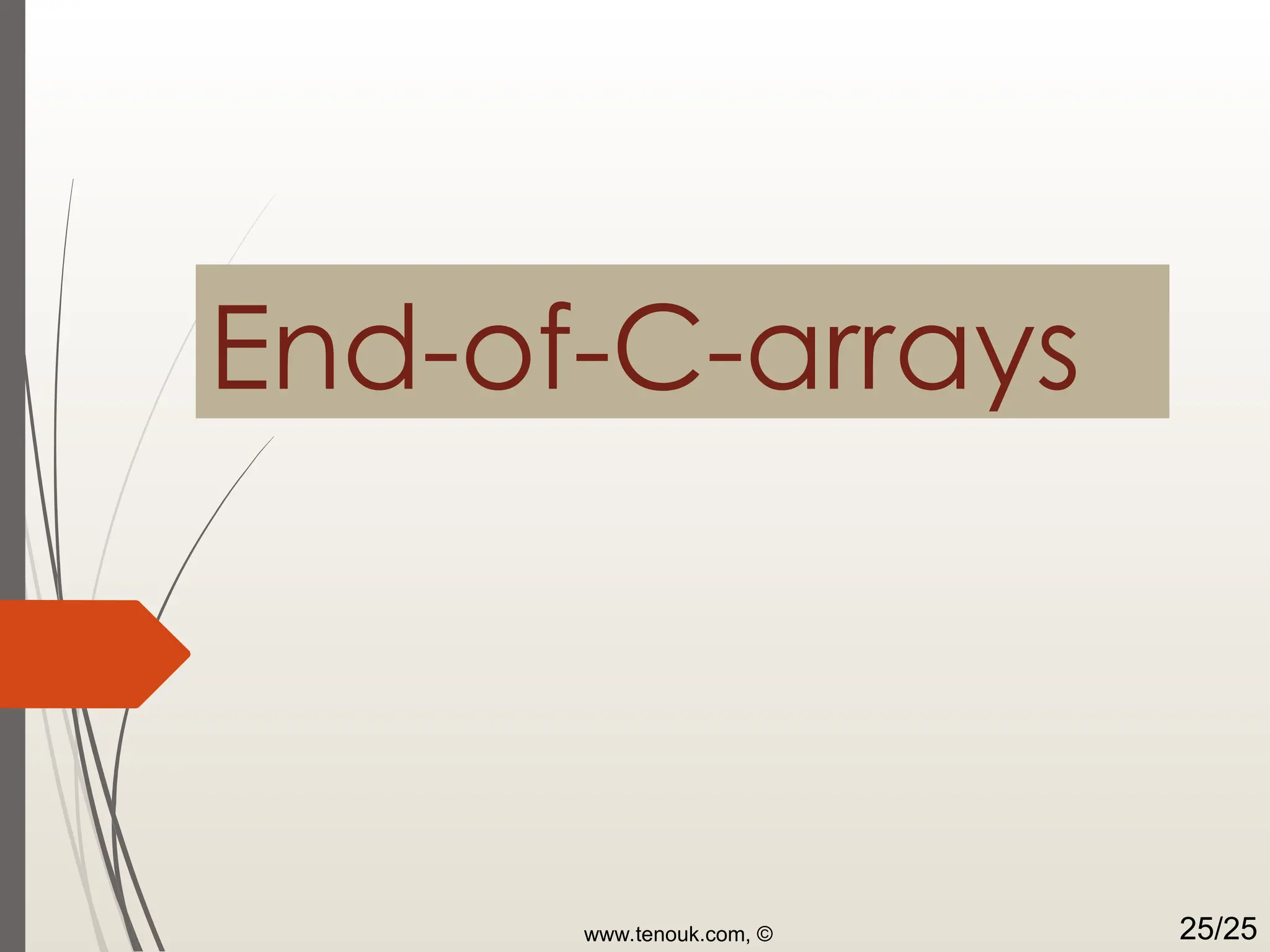More Related Content
C programming , array 2020 C array 1 and 2 dimension array, declaration.ppt Array THE DATA STRUCTURE. ITS THE STRUCT Similar to cprogrammingarrayaggregatetype.ppt very easy to lear
C (PPS)Programming for problem solving.pptx Array ppt you can learn in very few slides. Homework Assignment – Array Technical DocumentWrite a technical .pdf Mesics lecture 8 arrays in 'c' Unit 3 How strings and arrays work in Programming.pdf Array and String in C Arrays - Introduction • Need of Arrays • Characterist... C Programming for Problem Solving programming Unit- 2 Array.pptx Array.pptxArray.pptx Array.pptxArray.pptxArray.pptx Unit ii data structure-converted Arrays_and_Strings_in_C_Programming.pptx Recently uploaded
kubernets: Kubernetes (often abbreviated as K8s) is an open-source platform f... MESSAGE AUTHENTICATION CODE in cryp.pptx USING GEN AI AGENTS WITH GAE AND VAE TO ENHANCE RESILIENCE OF US MARKETS CHAPTER 3_HYDROLOGIC STATISTICS AND FREQUENCY ANALYSIS.pptx sem7 major project 123456779765433212234 vtlecture22011 total quality management.ppt 906186982-SIH-2024-Winning-PPT.pptx sih winning Batteries_ Technology, Applications and Sustainability.pptx Drone Supported by modular optical systems Request for Information - #10547 CBTC 2nd International Conference on AI, Machine Learning and Data Science (AIMDS ... B. Tech Sem 1 Gravimetric Chemical Analysis - Copy.pptx Unit - IMETAL CUTTING MACHINING PROCESS.ppt LNG Basics by Choi SPE LNG Processes Introduction LNG Basics by Choi SPE Introductory Liquefaction Lecture Back to the Future - A look back at Agile Engineering Practices and their Fut... Bench_fitting_tool_mechanical_workshop.ppt Why Did The submarine Kursk Sink? What went wrong? Certified Cloud Security Professional (CCSP): Unit 5 Class 3 of Module 2 - Strings in Python Syllabus, VIT cprogrammingarrayaggregatetype.ppt very easy to lear
- 1.
- 2.
ARRAYS An arrayis a collection of elements of the same type that are referenced by a common name. Compared to the basic data type (int, float & char) it is an aggregate or derived data type. All the elements of an array occupy a set of contiguous memory locations. Why need to use array type? Consider the following issue: "We have a list of 1000 students' marks of an integer type. If using the basic data type (int), we will declare something like the following…" int studMark0, studMark1, studMark2, ..., studMark999; www.tenouk.com, © 2/25 - 3.
ARRAYS Can youimagine how long we have to write the declaration part by using normal variable declaration? int main(void) { int studMark1, studMark2, studMark3, studMark4, …, …, studMark998, stuMark999, studMark1000; … … return 0; } www.tenouk.com, © 3/25 - 4.
ARRAYS By usingan array, we just declare like this, int studMark[1000]; This will reserve 1000 contiguous memory locations for storing the students’ marks. Graphically, this can be depicted as in the following figure. www.tenouk.com, © 4/25 - 5.
ARRAYS This absolutelyhas simplified our declaration of the variables. We can use index or subscript to identify each element or location in the memory. Hence, if we have an index of jIndex, studMark[jIndex] would refer to the jIndexth element in the array of studMark. For example, studMark[0] will refer to the first element of the array. Thus by changing the value of jIndex, we could refer to any element in the array. So, array has simplified our declaration and of course, manipulation of the data. www.tenouk.com, © 5/25 - 6.
ARRAYS One Dimensional Array:Declaration Dimension refers to the array's size, which is how big the array is. A single or one dimensional array declaration has the following form, array_element_data_type array_name[array_size]; Here, array_element_data_type define the base type of the array, which is the type of each element in the array. array_name is any valid C / C++ identifier name that obeys the same rule for the identifier naming. array_size defines how many elements the array will hold. www.tenouk.com, © 6/25 - 7.
ARRAYS For example,to declare an array of 30 characters, that construct a people name, we could declare, char cName[30]; Which can be depicted as follows, In this statement, the array character can store up to 30 characters with the first character occupying location cName[0] and the last character occupying cName[29]. Note that the index runs from 0 to 29. In C, an index always starts from 0 and ends with array's (size-1). So, take note the difference between the array size and subscript/index terms. www.tenouk.com, © 7/25 - 8.
ARRAYS Examples ofthe one-dimensional array declarations, int xNum[20], yNum[50]; float fPrice[10], fYield; char chLetter[70]; The first example declares two arrays named xNum and yNum of type int. Array xNum can store up to 20 integer numbers while yNum can store up to 50 numbers. The second line declares the array fPrice of type float. It can store up to 10 floating-point values. fYield is basic variable which shows array type can be declared together with basic type provided the type is similar. The third line declares the array chLetter of type char. It can store a string up to 69 characters. Why 69 instead of 70? Remember, a string has a null terminating character (0) at the end, so we must reserve for it. www.tenouk.com, © 8/25 - 9.
ARRAYS Array Initialization Anarray may be initialized at the time of declaration. Giving initial values to an array. Initialization of an array may take the following form, type array_name[size] = {a_list_of_value}; For example: int idNum[7] = {1, 2, 3, 4, 5, 6, 7}; float fFloatNum[5] = {5.6, 5.7, 5.8, 5.9, 6.1}; char chVowel[6] = {'a', 'e', 'i', 'o', 'u', '0'}; The first line declares an integer array idNum and it immediately assigns the values 1, 2, 3, ..., 7 to idNum[0], idNum[1], idNum[2],..., idNum[6] respectively. The second line assigns the values 5.6 to fFloatNum[0], 5.7 to fFloatNum[1], and so on. Similarly the third line assigns the characters 'a' to chVowel[0], 'e' to chVowel[1], and so on. Note again, for characters we must use the single apostrophe/quote (') to enclose them. Also, the last character in chVowel is NULL character ('0'). www.tenouk.com, © 9/25 - 10.
ARRAYS Initialization ofan array of type char for holding strings may take the following form, char array_name[size] = "string_lateral_constant"; For example, the array chVowel in the previous example could have been written more compactly as follows, char chVowel[6] = "aeiou"; When the value assigned to a character array is a string (which must be enclosed in double quotes), the compiler automatically supplies the NULL character but we still have to reserve one extra place for the NULL. For unsized array (variable sized), we can declare as follow, char chName[ ] = "Mr. Dracula"; C compiler automatically creates an array which is big enough to hold all the initializer. www.tenouk.com, © 10/25 - 11.
ARRAYS Arrays allowprogrammers to group related items of the same data type in one variable. However, when referring to an array, one has to specify not only the array or variable name but also the index number of interest. Program example 1: Sum of array’s element. Notice the array's element which is not initialized is set to 0 automatically. www.tenouk.com, © 11/25 - 12.
ARRAYS Program example2: Searching the smallest value. Finding the smallest element in the array named fSmallest. First, it assumes that the smallest value is in fSmallest[0] and assigns it to the variable nSmall. Then it compares nSmall with the rest of the values in fSmallest, one at a time. When an element is smaller than the current value contained in nSmall, it is assigned to nSmall. The process finally places the smallest array element in nSmall. www.tenouk.com, © 12/25 - 13.
ARRAYS Program example3: Searching the biggest valu e . By modifying the previous example we can search the biggest value. www.tenouk.com, © 13/25 - 14.
- 15.
- 16.
- 17.
ARRAYS Two Dimensional/2D Arrays A two dimensional array has two subscripts/indexes. The first subscript refers to the row, and the second, to the column. Its declaration has the following form, data_type array_name[1st dimension size][2nd dimension size]; For examples, int xInteger[3][4]; float matrixNum[20][25]; The first line declares xInteger as an integer array with 3 rows and 4 columns. Second line declares a matrixNum as a floating-point array with 20 rows and 25 columns. www.tenouk.com, © 17/25 - 18.
ARRAYS If weassign initial string values for the 2D array it will look something like the following, char Name[6][10] = {"Mr. Bean", "Mr. Bush", "Nicole", "Kidman", "Arnold", "Jodie"}; Here, we can initialize the array with 6 strings, each with maximum 9 characters long. If depicted in rows and columns it will look something like the following and can be considered as contiguous arrangement in the memory. www.tenouk.com, © 18/25 - 19.
ARRAYS Take notethat for strings the null character (0) still needed. From the shaded square area of the figure we can determine the size of the array. For an array Name[6][10], the array size is 6 x 10 = 60 and equal to the number of the colored square. In general, for array_name[x][y]; The array size is = First index x second index = xy. This also true for other array dimension, for example three dimensional array, array_name[x][y][z]; => First index x second index x third index = xyz For example, ThreeDimArray[2][4][7] = 2 x 4 x 7 = 56. And if you want to illustrate the 3D array, it could be a cube with wide, long and height dimensions. www.tenouk.com, © 19/25 - 20.
- 21.
ARRAYS Program example8: Swapping iIndex (iR ow) with jIndex (iColumn) in the previous program example www.tenouk.com, © 21/25 - 22.
ARRAYS 1. Program example9: Strings are read in by the rows. 2. Each row will have one string. Enter the following data: “you”, “are”, “cat” for the following example. 3. Remember that after each string, a null character is added. 4. We are reading in strings but printing out only characters. www.tenouk.com, © 22/25 - 23.
ARRAYS The contentsof the array in memory after the three strings are read in the array. Re-run the program, enter the following data: “you”, “my”. Illustrates the content as done previously. www.tenouk.com, © 23/25 - 24.
ARRAYS 1. Does youroutput agree? 2. How is the null character, '0' printed? 3. Is there a garbage character in a[1][3]? If so, why? a) The output matched, except the garbage. b) Just an empty space. c) Yes. This slot has been reserved but not filled so whatever the previous data that has been stored here would be displayed (if possible). www.tenouk.com, © 24/25 - 25.

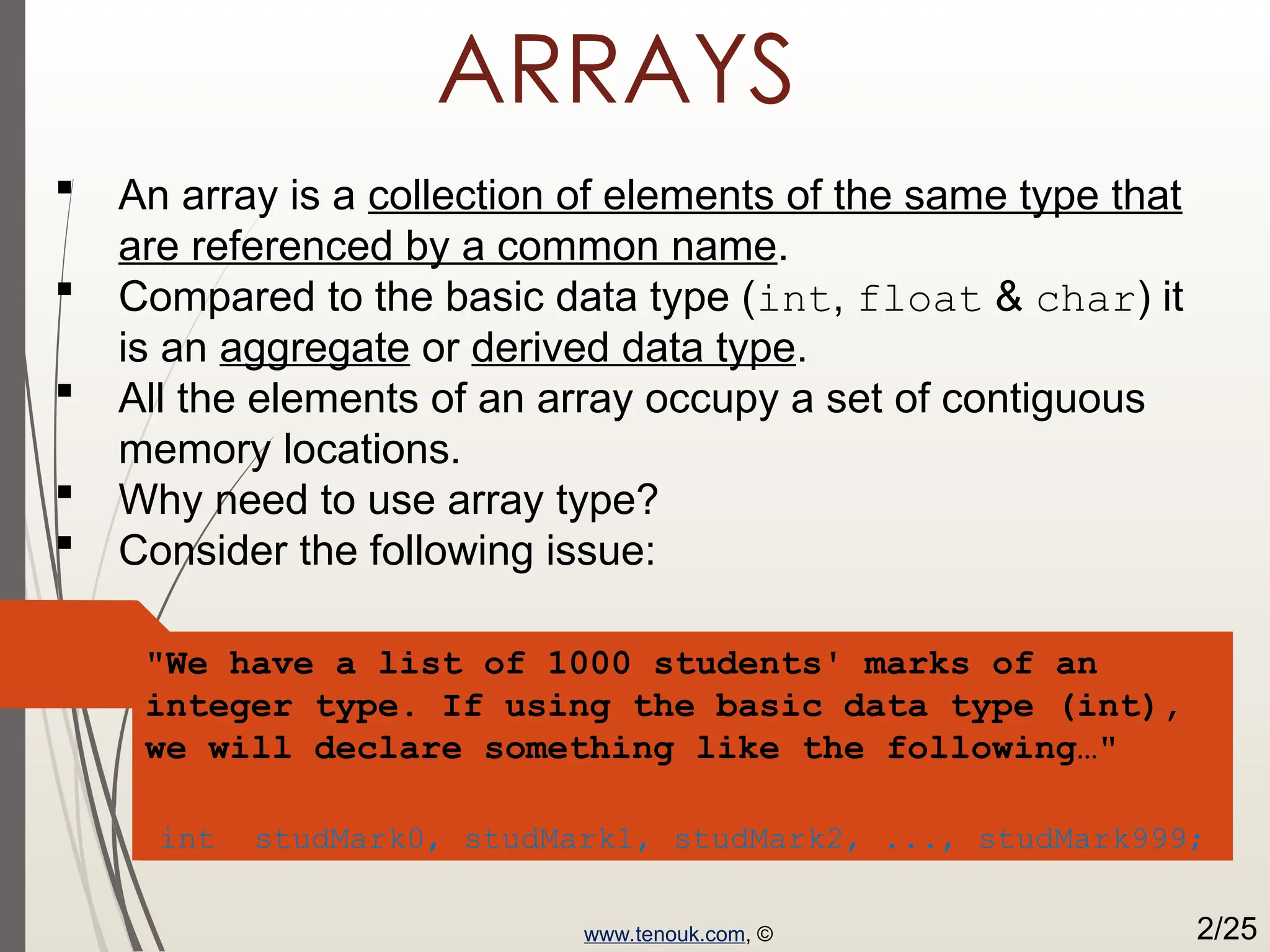
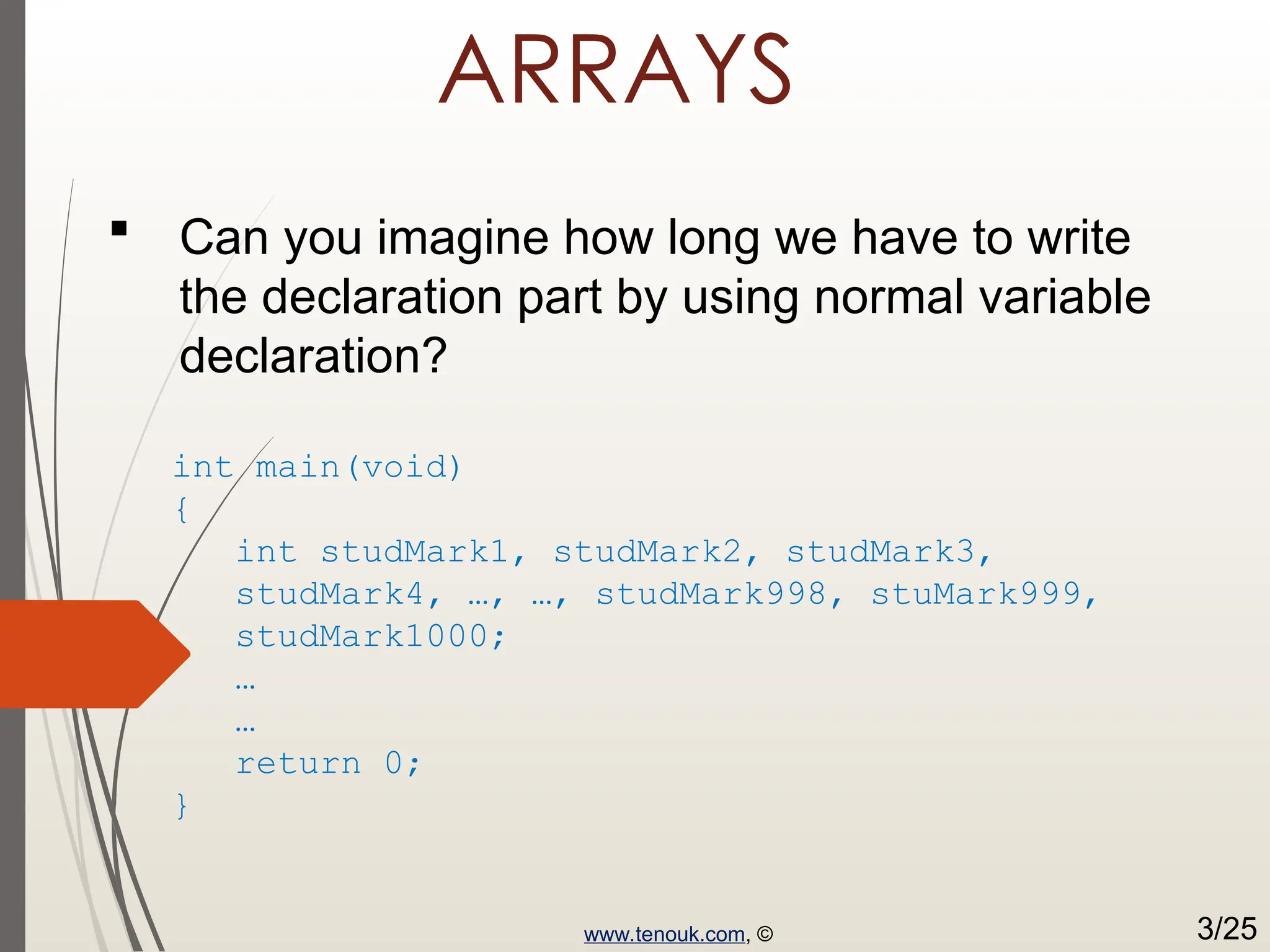
![ARRAYS By using an array, we just declare like this, int studMark[1000]; This will reserve 1000 contiguous memory locations for storing the students’ marks. Graphically, this can be depicted as in the following figure. www.tenouk.com, © 4/25](https://image.slidesharecdn.com/cprogrammingarrayaggregatetype-250327064018-afe1abd5/75/cprogrammingarrayaggregatetype-ppt-very-easy-to-lear-4-2048.jpg)
![ARRAYS This absolutely has simplified our declaration of the variables. We can use index or subscript to identify each element or location in the memory. Hence, if we have an index of jIndex, studMark[jIndex] would refer to the jIndexth element in the array of studMark. For example, studMark[0] will refer to the first element of the array. Thus by changing the value of jIndex, we could refer to any element in the array. So, array has simplified our declaration and of course, manipulation of the data. www.tenouk.com, © 5/25](https://image.slidesharecdn.com/cprogrammingarrayaggregatetype-250327064018-afe1abd5/75/cprogrammingarrayaggregatetype-ppt-very-easy-to-lear-5-2048.jpg)
![ARRAYS One Dimensional Array: Declaration Dimension refers to the array's size, which is how big the array is. A single or one dimensional array declaration has the following form, array_element_data_type array_name[array_size]; Here, array_element_data_type define the base type of the array, which is the type of each element in the array. array_name is any valid C / C++ identifier name that obeys the same rule for the identifier naming. array_size defines how many elements the array will hold. www.tenouk.com, © 6/25](https://image.slidesharecdn.com/cprogrammingarrayaggregatetype-250327064018-afe1abd5/75/cprogrammingarrayaggregatetype-ppt-very-easy-to-lear-6-2048.jpg)
![ARRAYS For example, to declare an array of 30 characters, that construct a people name, we could declare, char cName[30]; Which can be depicted as follows, In this statement, the array character can store up to 30 characters with the first character occupying location cName[0] and the last character occupying cName[29]. Note that the index runs from 0 to 29. In C, an index always starts from 0 and ends with array's (size-1). So, take note the difference between the array size and subscript/index terms. www.tenouk.com, © 7/25](https://image.slidesharecdn.com/cprogrammingarrayaggregatetype-250327064018-afe1abd5/75/cprogrammingarrayaggregatetype-ppt-very-easy-to-lear-7-2048.jpg)
![ARRAYS Examples of the one-dimensional array declarations, int xNum[20], yNum[50]; float fPrice[10], fYield; char chLetter[70]; The first example declares two arrays named xNum and yNum of type int. Array xNum can store up to 20 integer numbers while yNum can store up to 50 numbers. The second line declares the array fPrice of type float. It can store up to 10 floating-point values. fYield is basic variable which shows array type can be declared together with basic type provided the type is similar. The third line declares the array chLetter of type char. It can store a string up to 69 characters. Why 69 instead of 70? Remember, a string has a null terminating character (0) at the end, so we must reserve for it. www.tenouk.com, © 8/25](https://image.slidesharecdn.com/cprogrammingarrayaggregatetype-250327064018-afe1abd5/75/cprogrammingarrayaggregatetype-ppt-very-easy-to-lear-8-2048.jpg)
![ARRAYS Array Initialization An array may be initialized at the time of declaration. Giving initial values to an array. Initialization of an array may take the following form, type array_name[size] = {a_list_of_value}; For example: int idNum[7] = {1, 2, 3, 4, 5, 6, 7}; float fFloatNum[5] = {5.6, 5.7, 5.8, 5.9, 6.1}; char chVowel[6] = {'a', 'e', 'i', 'o', 'u', '0'}; The first line declares an integer array idNum and it immediately assigns the values 1, 2, 3, ..., 7 to idNum[0], idNum[1], idNum[2],..., idNum[6] respectively. The second line assigns the values 5.6 to fFloatNum[0], 5.7 to fFloatNum[1], and so on. Similarly the third line assigns the characters 'a' to chVowel[0], 'e' to chVowel[1], and so on. Note again, for characters we must use the single apostrophe/quote (') to enclose them. Also, the last character in chVowel is NULL character ('0'). www.tenouk.com, © 9/25](https://image.slidesharecdn.com/cprogrammingarrayaggregatetype-250327064018-afe1abd5/75/cprogrammingarrayaggregatetype-ppt-very-easy-to-lear-9-2048.jpg)
![ARRAYS Initialization of an array of type char for holding strings may take the following form, char array_name[size] = "string_lateral_constant"; For example, the array chVowel in the previous example could have been written more compactly as follows, char chVowel[6] = "aeiou"; When the value assigned to a character array is a string (which must be enclosed in double quotes), the compiler automatically supplies the NULL character but we still have to reserve one extra place for the NULL. For unsized array (variable sized), we can declare as follow, char chName[ ] = "Mr. Dracula"; C compiler automatically creates an array which is big enough to hold all the initializer. www.tenouk.com, © 10/25](https://image.slidesharecdn.com/cprogrammingarrayaggregatetype-250327064018-afe1abd5/75/cprogrammingarrayaggregatetype-ppt-very-easy-to-lear-10-2048.jpg)
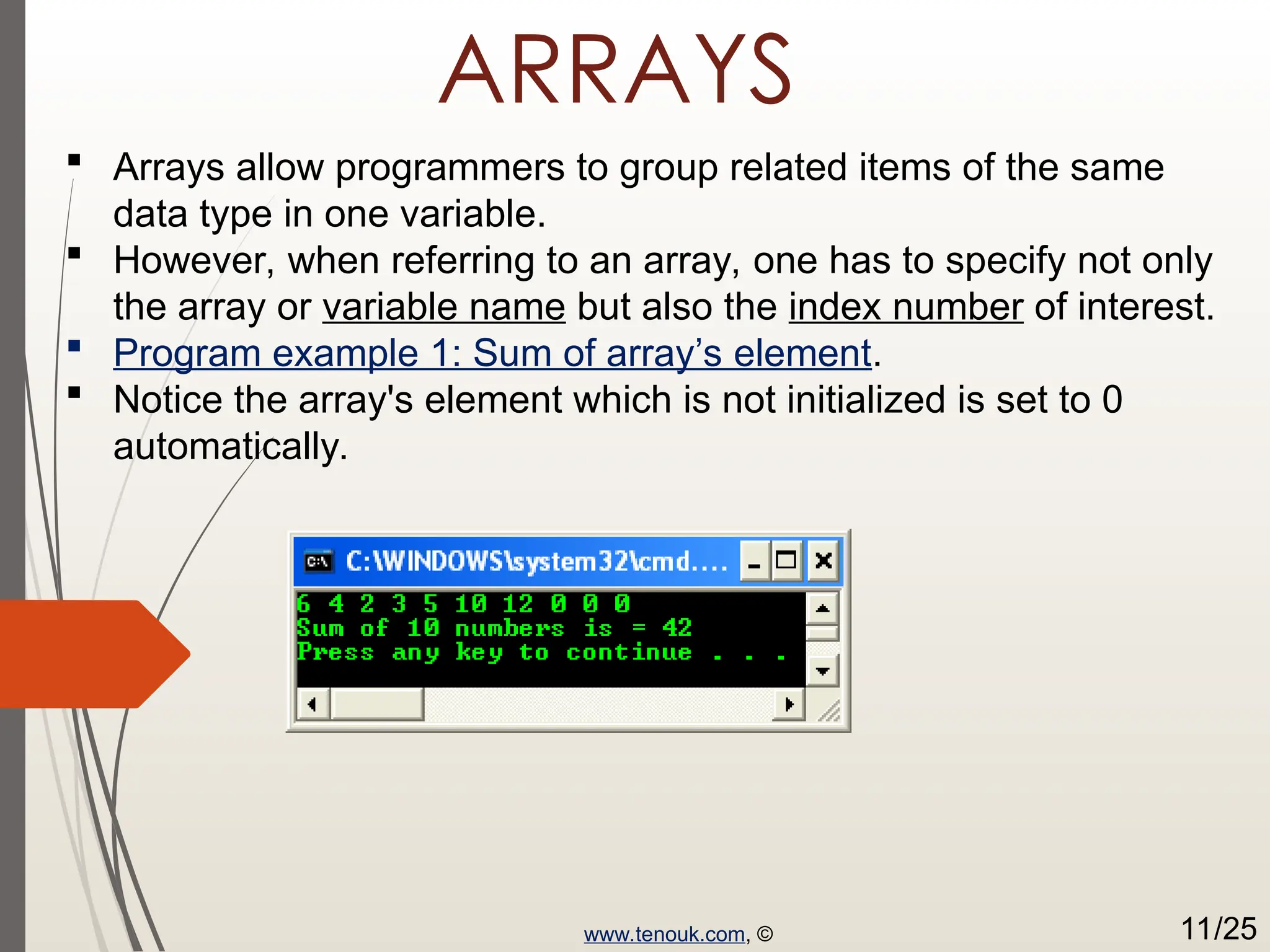
![ARRAYS Program example 2: Searching the smallest value. Finding the smallest element in the array named fSmallest. First, it assumes that the smallest value is in fSmallest[0] and assigns it to the variable nSmall. Then it compares nSmall with the rest of the values in fSmallest, one at a time. When an element is smaller than the current value contained in nSmall, it is assigned to nSmall. The process finally places the smallest array element in nSmall. www.tenouk.com, © 12/25](https://image.slidesharecdn.com/cprogrammingarrayaggregatetype-250327064018-afe1abd5/75/cprogrammingarrayaggregatetype-ppt-very-easy-to-lear-12-2048.jpg)

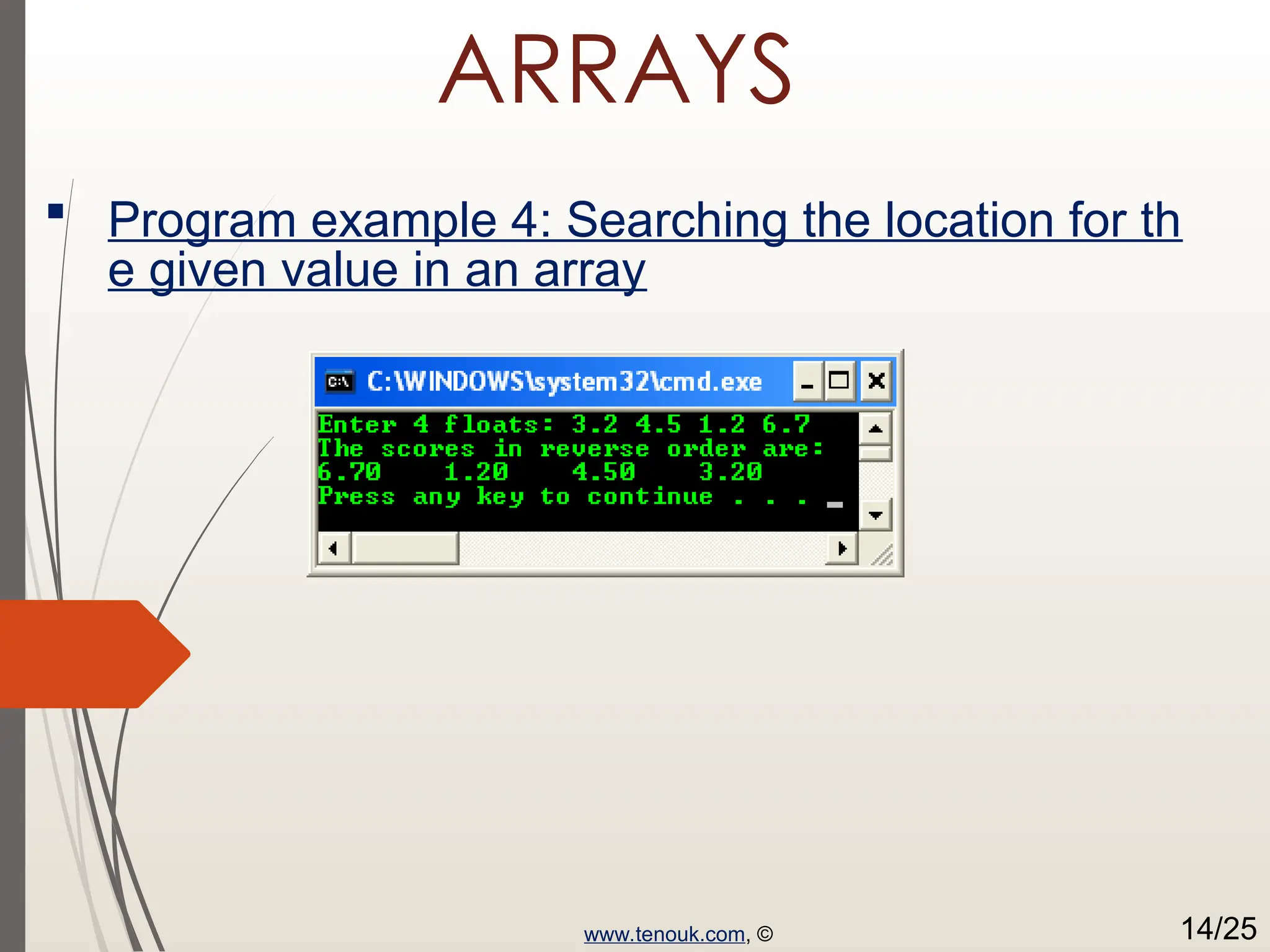


![ARRAYS Two Dimensional/2D Arrays A two dimensional array has two subscripts/indexes. The first subscript refers to the row, and the second, to the column. Its declaration has the following form, data_type array_name[1st dimension size][2nd dimension size]; For examples, int xInteger[3][4]; float matrixNum[20][25]; The first line declares xInteger as an integer array with 3 rows and 4 columns. Second line declares a matrixNum as a floating-point array with 20 rows and 25 columns. www.tenouk.com, © 17/25](https://image.slidesharecdn.com/cprogrammingarrayaggregatetype-250327064018-afe1abd5/75/cprogrammingarrayaggregatetype-ppt-very-easy-to-lear-17-2048.jpg)
![ARRAYS If we assign initial string values for the 2D array it will look something like the following, char Name[6][10] = {"Mr. Bean", "Mr. Bush", "Nicole", "Kidman", "Arnold", "Jodie"}; Here, we can initialize the array with 6 strings, each with maximum 9 characters long. If depicted in rows and columns it will look something like the following and can be considered as contiguous arrangement in the memory. www.tenouk.com, © 18/25](https://image.slidesharecdn.com/cprogrammingarrayaggregatetype-250327064018-afe1abd5/75/cprogrammingarrayaggregatetype-ppt-very-easy-to-lear-18-2048.jpg)
![ARRAYS Take note that for strings the null character (0) still needed. From the shaded square area of the figure we can determine the size of the array. For an array Name[6][10], the array size is 6 x 10 = 60 and equal to the number of the colored square. In general, for array_name[x][y]; The array size is = First index x second index = xy. This also true for other array dimension, for example three dimensional array, array_name[x][y][z]; => First index x second index x third index = xyz For example, ThreeDimArray[2][4][7] = 2 x 4 x 7 = 56. And if you want to illustrate the 3D array, it could be a cube with wide, long and height dimensions. www.tenouk.com, © 19/25](https://image.slidesharecdn.com/cprogrammingarrayaggregatetype-250327064018-afe1abd5/75/cprogrammingarrayaggregatetype-ppt-very-easy-to-lear-19-2048.jpg)


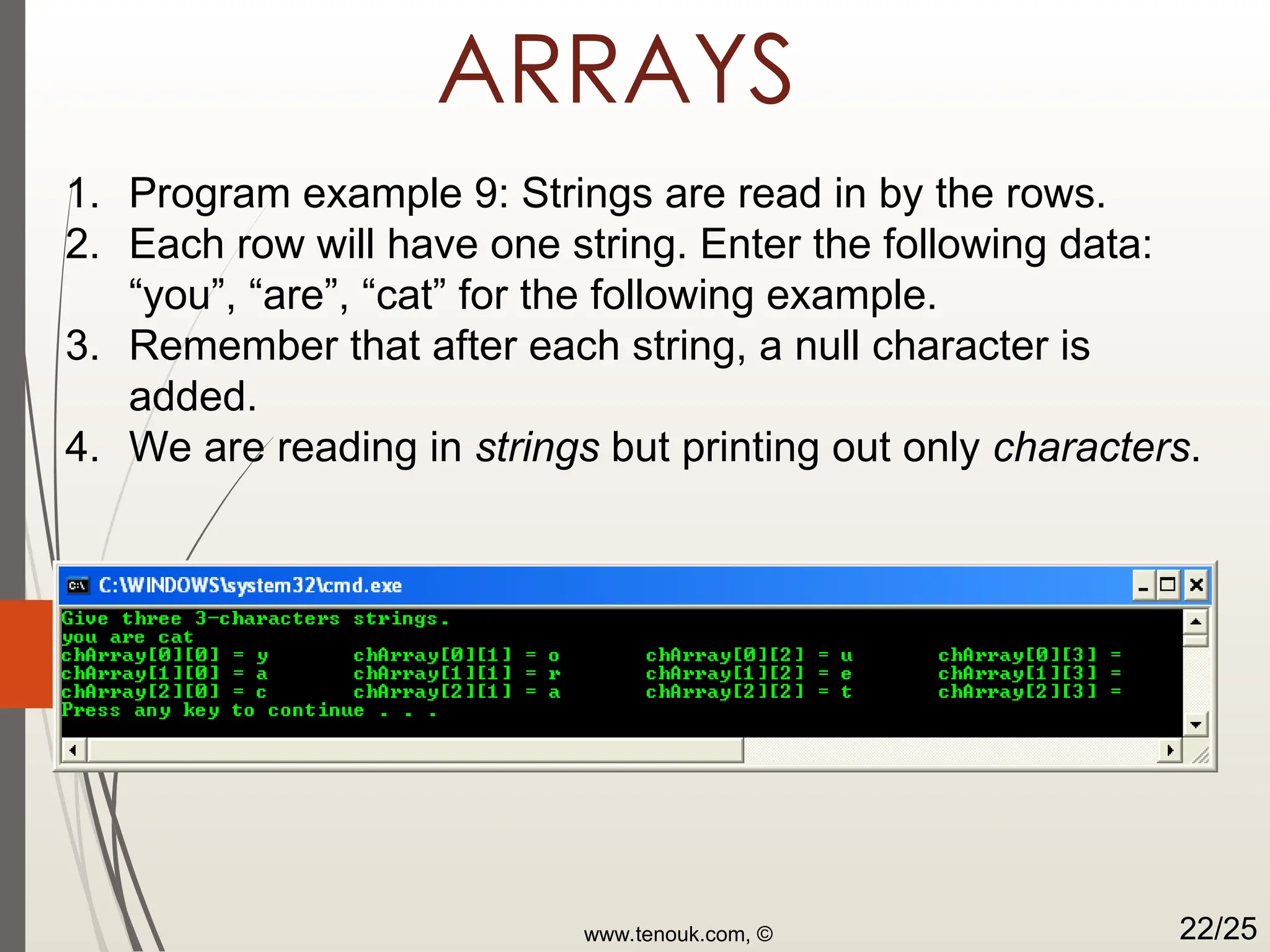

![ARRAYS 1. Does your output agree? 2. How is the null character, '0' printed? 3. Is there a garbage character in a[1][3]? If so, why? a) The output matched, except the garbage. b) Just an empty space. c) Yes. This slot has been reserved but not filled so whatever the previous data that has been stored here would be displayed (if possible). www.tenouk.com, © 24/25](https://image.slidesharecdn.com/cprogrammingarrayaggregatetype-250327064018-afe1abd5/75/cprogrammingarrayaggregatetype-ppt-very-easy-to-lear-24-2048.jpg)
